Neill's Geology:
Glaciologists

Home / Gemmologists / Marine Geologists / Paleontologists / Seismologists / Vulcanologists
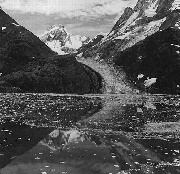
The night is cold. All around you, snow and ice.
You shiver and pull your coat around you a little tighter. Everything is dark. And then, out of nowhere, looms a huge block of coagulated snow and ice!
It's over forty meters across, and headed straight for you at
the breakneck speed of two inches per day!!
What is next for our hero? Will you escape the ferocious glacier or perish in the Arctic weather???
The truth is, glaciers are not ferocious, but I wanted to get your
ATTENTION!!!
Did you ever just look at a glacier and wonder "What the heck is that?"
Sure you have; we've all been there. Well, now's your chance to know!!!
break
 The Making of a Glacier:
The Making of a Glacier: 
 What is a glacier actually made of, anyway? How does all that snow and ice get packed down into something as HUGE as a glacier?
What is a glacier actually made of, anyway? How does all that snow and ice get packed down into something as HUGE as a glacier?Well, it's like this:
Glaciers are formed on land, in very cold places where the snow never melts.
Snow accumulates in these places for HUNDREDS and THOUSANDS of years!!!
All that snow gets pushed down and compacted by the weight of the snow on top.
Finally, the snow gets pushed down so hard that it forms a solid.
And what a solid it is!!!
break
 The Moving of a Glacier:
The Moving of a Glacier: 
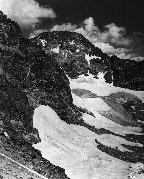 So glaciers are made up of concentrated snow. So what?
So glaciers are made up of concentrated snow. So what?Well, glaciers wouldn't be interesting if they just sat there, would they? So, just to keep things exciting, glaciers MOVE!!
But how? HOOOOWWWW??? Let me tell you.
It's all about gravity! Gravity pulls the glacier, starting when it reaches critical mass, or about 18 meters thick. The bottom of the glacier actually moves slower than the top of the glacier, because it drags and scrapes along the ground. Whether it is advancing or retreating, the bottom is always moving slower than the top!!
break
 The Parts of a Glacier:
The Parts of a Glacier: 
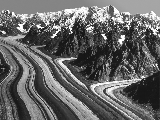 The coldest part of a glacier is usually the accumulation area. This is where the glacier is gaining snow. Near the bottom is the ablation area, where the glaciers lose snow and ice.
The coldest part of a glacier is usually the accumulation area. This is where the glacier is gaining snow. Near the bottom is the ablation area, where the glaciers lose snow and ice.In the middle is the equilibrium.
Crevasses are deep trenches formed by the glacier pulling apart, and moraines are the dark bands you can see in this picture, which carry rocky debris. Terminal moraines are big mounds of earth pushed
up in front of the glacier as it moves forwards.
Lateral moraines are lines of pushed-up debris on the sides of glaciers. When the glacier retreats, the terminal moraines remain, looking like big snakes made out of dirt!!
break
 The Wake of a Glacier:
The Wake of a Glacier: 
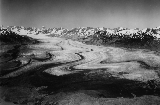 So, what does this big pile of rolling snow and ice do to the land it goes over?
Well, a bunch! We've already talked about moraines. But when the huge glacier passes over the land, it makes a lot of changes. There are things called tills, which are all the little bits of rocks and soil that are left behind as a glacier moves forward. Kettles are chunks of ice buried by the glacier that melt to form little lakes. Sometimes, the glacier drops out rocky material while it is still moving, and then goes over it, creating little hills called drumlins. When the glacier moves through a valley, it scrapes along the sides of the surrounding mountains, creating grooves and striations. If you see these things in the land around you, chances are, a glacier passed that way!!
So, what does this big pile of rolling snow and ice do to the land it goes over?
Well, a bunch! We've already talked about moraines. But when the huge glacier passes over the land, it makes a lot of changes. There are things called tills, which are all the little bits of rocks and soil that are left behind as a glacier moves forward. Kettles are chunks of ice buried by the glacier that melt to form little lakes. Sometimes, the glacier drops out rocky material while it is still moving, and then goes over it, creating little hills called drumlins. When the glacier moves through a valley, it scrapes along the sides of the surrounding mountains, creating grooves and striations. If you see these things in the land around you, chances are, a glacier passed that way!!
break
 Glaciers of the World:
Glaciers of the World: 
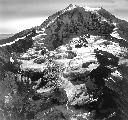 So, when you think of glaciers, you think of the North and South Poles, right? Well, there are glaciers there, but did you know that there are glaciers on every continent?!? That's right! The countries with the three largest glacier areas are Antarctica, Greenland, and Canada, respectively. Did you know the United States has more glacier area than Iceland? Pretty cool! There are even glaciers in Africa! That's because some glaciers form on the water and ground in very cold places. But in hotter countries, or anywhere really, glaciers form at very high altitudes, like on the tops of mountains! They usually don't get very far in warm places though, because as they travel down the mountain, it gets warmer and they melt.
So, when you think of glaciers, you think of the North and South Poles, right? Well, there are glaciers there, but did you know that there are glaciers on every continent?!? That's right! The countries with the three largest glacier areas are Antarctica, Greenland, and Canada, respectively. Did you know the United States has more glacier area than Iceland? Pretty cool! There are even glaciers in Africa! That's because some glaciers form on the water and ground in very cold places. But in hotter countries, or anywhere really, glaciers form at very high altitudes, like on the tops of mountains! They usually don't get very far in warm places though, because as they travel down the mountain, it gets warmer and they melt.
break
Is Glaciology So Cool You Just Can't Stand It?!?
Well, check these places out!
NSIDC Education: GlaciersGeologyLink: Glaciers
Ice Age Paleoecology
Pictures Courtesy Of:
National Snow and Ice Data Center

Geology Contest / Disasters! / Ask-A-Geologist / Links
About the Author / Contest Winners! / What can YOU do?
Do you have any questions, or ideas on how to make this a better site?
If so, please e-mail me here.